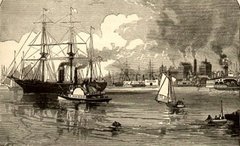Hudson River
|
|
The Hudson River, called Muh-he-kun-ne-tuk in Mahican, is a river running mainly through New York State but partly forming the boundary between the states of New York and New Jersey. It is named for Henry Hudson, an Englishman sailing for the Netherlands, who explored it in 1609, though the first European to see it, in 1524, was the Italian Giovanni da Verrazano whose expedition was financed by the citizens of Lyon, France, under the auspices of King Francois I. Early European settlement of the area clustered around the river.
The official source of the Hudson is Lake Tear-of-the-Clouds in the Adirondack Mountains. The Hudson is joined near Albany by the Mohawk River, its major tributary and flows south until it reaches the Atlantic Ocean between Manhattan Island and New Jersey, forming New York Harbor, at New York Bay, an arm of the Atlantic Ocean. The Hudson as it passes through New York City is also known as the North River. There are also parts of the Hudson river that form coves. An example of this is Weehawken Cove (illustration, left), partly in Hoboken and partly in Weehawken.
DSCF0073.JPG
The Hudson and its tributaries—notably the Mohawk River—drain a large area, and the river is navigable for a great distance. The Erie Canal, opened December 26, 1825, connected the Hudson River to Lake Erie, enabling shipping between cities on the Great Lakes and Europe via the Atlantic Ocean.
The Hudson is sometimes called a "drowned" river. The rising sea levels after the retreat of the Wisconsinan glaciation, the most recent ice age, have resulted in a marine incursion that drowned the coastal plain and brought salt water well above the mouth of the river. The deeply-eroded old riverbed beyond the current shoreline, Hudson Canyon, is a rich fishing area. The former riverbed is clearly delineated beneath the waters of the Atlantic Ocean, extending to the edge of the continental shelf. The Mahican name of the river, Muh-he-kun-ne-tuk, means "the river that flows both ways" and refers to the tide-driven intermixing of fresh and salt water which takes place in the middle region of the Hudson.
The lower part of the river near Manhattan is a tidal estuary, with strong tides making parts of New York Harbor difficult and dangerous to navigate.
The Hudson is crossed at numerous points by bridges and tunnels. The width of the river in its southern half required major feats of engineering to bridge, the results today visible in the Verrazano-Narrows and George Washington Bridges, as well as the Lincoln and Holland Tunnels.
Notable landmarks on the Hudson include West Point, the Thayer Hotel, Bannerman's Castle, Metro-North Railroad's Hudson River Line (formerly part of the New York Central system), Hudson River Park, Liberty State Park, and Stevens Institute of Technology. Cities and towns on the New Jersey side include Fort Lee, Weehawken, Hoboken, and Jersey City. Cities and towns on the New York side include Troy, Albany, Kingston, Poughkeepsie, Beacon, Yonkers, and New York City (Manhattan, The Bronx).
Hudson_River_NASA.jpg
Hudson_river_from_bear_mountain_bridge.jpg
Crossings
From South to North:
- PATH downtown transit tunnels (c. 1907)
- Holland Tunnel (1927)
- PATH uptown transit tunnels (c. 1911)
- Pennsylvania Railroad tunnel to Penn Station (now Amtrak, NJ Transit) (c. 1908)
- Lincoln Tunnel (1937)
- George Washington Bridge (1931)
- Tappan Zee Bridge (1955)
- Bear Mountain Bridge (1924)
- Newburgh-Beacon Bridge, Newburgh, New York (1963)
- Mid-Hudson Bridge, near Poughkeepsie, New York (1930)
- Poughkeepsie Railroad Bridge, near Poughkeepsie, New York (1888)
- Kingston-Rhinecliff Bridge (1957)
- Rip Van Winkle Bridge, Catskill, New York (1935)
- Alfred H. Smith Memorial Bridge (railroad bridge), Castleton-on-Hudson, New York (1924)
- New York State Thruway bridge, Berkshire Spur connection to Interstate 87, Castleton-on-Hudson, New York
- Dunn Memorial Bridge, Rensselaer, New York (1969)
- Livingston Avenue Railroad Bridge between Albany and Rensselaer (1866)
- Patroon Island Bridge, Interstate 90, between Albany and Rensselaer
- Menands Bridge in Troy, New York
- Congress Street Bridge in Troy, New York
- Green Island Bridge in Troy, New York (1982)
- Collar City Bridge in Troy, New York carrying New York State Highway 7
- 112th Street Bridge in Troy, New York
- Troy/Waterford Bridge connecting northern Troy, New York to Waterford, New York
- Howland Avenue Bridge in Mechanicville, New York carrying New York State Highway 67
- Railroad bridge in Mechanicville, New York
- Stillwater Bridge in Stillwater, New York
- Schuylerville Bridge in Schuylerville, New York carrying New York State Highway 29
- Dix Bridge in Schuylerville, New York
- U.S. Highway 4 bridge in Thomson, New York
- New York State Highway 197 bridge in Fort Edward, New York
- Hudson Falls Bridge in Hudson Falls, New York
- U.S. Highway 9/New York State Highway 32 Bridge in Glens Falls, New York
- Interstate 87 bridge near West Glens Falls, New York
- Corinth Bridge in Corinth, New York
- New York State Highway 9N bridge near Lake Luzerne, New York
- Lake Luzerne Bridge in Hadley, New York and Lake Luzerne, New York
- Thurman Station Bridge in Warrensburg, New York and Thurman, New Yorkde:Hudson River
es:Río Hudson ja:ハドソン川 nl:Hudson (rivier) pl:Hudson (rzeka) pt:Rio Hudson sv:Hudsonfloden


